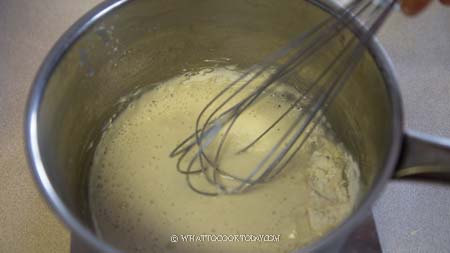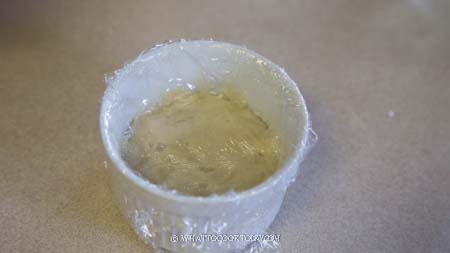This post may contain affiliate links. Please read our disclosure policy.
The goal of this tutorial is to show you how to prepare a tangzhong properly to draw the maximum benefits from it. The bread will stay soft for days and the quality and taste of the bread improve as well.

What is tangzhong?
Tangzhong, or I call it a natural dough improver, is used in bread making that involves cooking a small portion of flour and water (or other liquid) to a certain temperature, which is then added to the remaining dough ingredients. The purpose of the tangzhong is to create a gel-like mixture that can retain moisture, resulting in bread that is softer, more tender, and stays fresher for longer. The technique originated in Japan and has since become popular in other parts of the world, particularly in Asian-style bread.
How To Prepare Tangzhong
Ingredients
Tangzhong 1:5 ratio
- 20 g bread flour see notes 1,2
- 100 g water see notes 3
Instructions
How to prepare tangzhong:
- Combine the flour and milk (or water) in a non-stick pan or a saucepan. Use a whisk to stir to combine until you don't see any more lumps. Put on the stove and turn the heat to low-medium and keep stirring
- The mixture will start to thicken. Remember to keep stirring and don't crank up the heat. If you use an instant-thermometer to measure, it should be about 65 C/149 F (a bit over is not a big deal). The mixture thickens but we don't want to overcook it and the liquid evaporates too much. Which is why using a thermometer helps a lot
If you prepare a double batch:
- The steps are the same as above but the cooking time may be a bit longer, about 4-5 minutes total when you cook over low-medium. I recommend weighing it when you pour it into a container so you know the weight after cooked and you can divide the weight by two when you need to use half of it
Cooling off:
- Once the tangzhong has reached the desired temperature, remove from the stove and cover with a cling wrap, touching the surface of the tangzhong directly to prevent a "skin" from forming on the surface. Let it sit at room temperature until it cools down completely
If you decide to use it right away:
- Once tangzhong has cooled down completely, you can incorporate it into your recipe
I recommend storing it for at least 8-12 hours for the maximum benefit
- If you have the time, once the tangzhong has cooled down, store it in the fridge for at least 8 hours or up to 2-3 days. This greatly improves the taste of your finished product. When ready to use, you don't need to let it come to a room temperature and it can be used in the recipe right away. I don't find any difference whether I let it comes to room temperature or not before I use it
RECOMMEDED TOOLS
Marv’s Recipe Notes
- You can also use bread flour, all-purpose flour, cake flour, or whole wheat flour to prepare tangzhong, depending on the recipe
- If you use whole wheat flour, let the whole wheat flour soaks in the milk/water for 15 minutes as whole wheat flour needs time to hydrate
- You can use dairy or non-dairy milk to prepare tangzhong
Ratio of tangzhong
The widely known ratio for making tangzhong is 1:5. You can see that most recipes on my blog that using tangzhong, use 1:5 ratio. I have been experimenting with 1:2 ratio and my family agrees that the 1:5 ratio gives much softer bread compared to when I use 1:2 ratio.
The amount of flour you use to prepare tangzhong can range from 4-10% of the total weight of the flour used in the recipe. I usually kinda take the middle road and try to do 6-7% or sometimes go up to 10%.
For example if a recipe is called for 350 grams of bread flour, and I decide to go for 7% and use 1:5 ratio. Then it’s going to be 0.07 x 350 = 25 grams. Then I will use 25 grams of bread flour and 125 grams of liquid (usually water or milk for most of my bread recipes).
Can I prepare a double batch of tangzhong?
Yes, I do it all the time because I bake so often and I use tangzhong a lot too. I don’t recommend preparing more than double though.
Can I use tangzhong immediately once it has cooled down?
I used to do that. I cook the tangzhong and then cool it down and use it right away. However, after learning about it from this video, I now prepare tangzhong and store it in the fridge overnight or up to 24 hours before using it. Why? Because not only does the tangzhong increase the shelf life of the bread, but the taste of the bread also improves when you let tangzhong sits longer, usually overnight for 8-12 hours or up to 2-3 days. So, to answer the question can I use tangzhong immediately after it cools down? the answer is yes you can. BUT, if you want even better flavor, then put it in the fridge for up to 24 hours before using
Can I freeze tangzhong?
I have kept them frozen on several different occasions and didn’t seem to have any adverse effects that I noticed. I didn’t keep them longer than a week though because I bake so often.
Recommended tool
You don’t need any fancy kitchen gadget to make tangzhong. But if you have an Instant-read thermometer or Infrared thermometer, it helps a lot to determine the correct temperature for the tangzhong without overcooking it and causing too much liquid to evaporate.
Step-by-step on how to prepare tangzhong
1. Combine the flour and milk (or water) in a non-stick pan or a saucepan. Use a whisk to stir to combine until you don’t see any more lumps. 
2. Put on the stove and turn the heat to low-medium and keep stirring. The mixture will start to thicken. Remember to keep stirring and don’t crank up the heat. If you use an instant-thermometer to measure, it should be about 65 C/149 F (a bit over is not a big deal). The mixture thickens but we don’t want to overcook it and the liquid evaporates too much. Which is why using a thermometer helps a lot
3. Once the tangzhong has reached the desired temperature, remove from the stove and cover with a cling wrap, touching the surface of the tangzhong directly to prevent a “skin” from forming on the surface. Let it sit at room temperature until it cools down completely
Recipes using tangzhong
Soft Fluffy Shokupan/Hokkaido Milk Bread
Tangzhong 100% whole wheat bread
Soft and Chewy Pork Floss Bagels with Tangzhong
Tangzhong Pandan Milk Buns with Inti Filling
Soft Red Bean Paste Baked Buns with Tangzhong
Whole Wheat Steamed Buns with Tangzhong
Sourdough Steamed Buns with Tangzhong
Did you prepare tangzhong using this tutorial?
I love it when you guys snap a photo and tag it to show me what you’ve made. Simply tag me @WhatToCookToday #WhatToCookToday on Instagram and I’ll be sure to stop by and take a peek for real!



